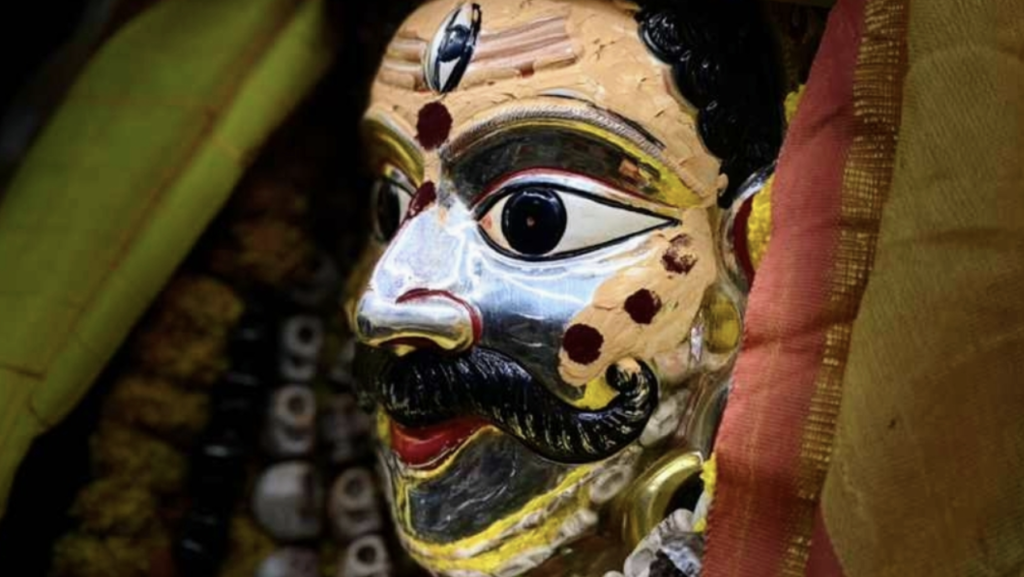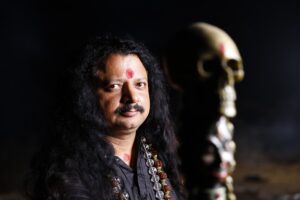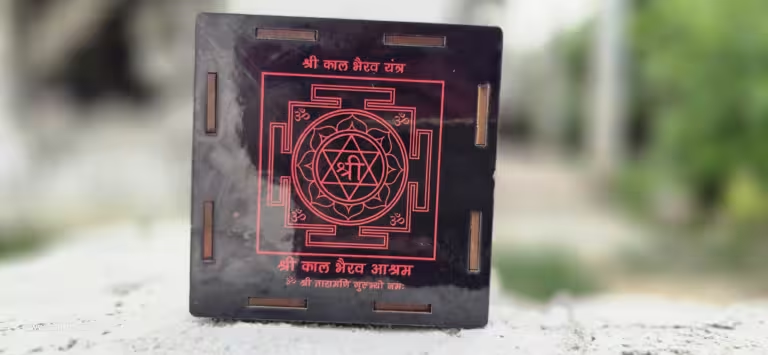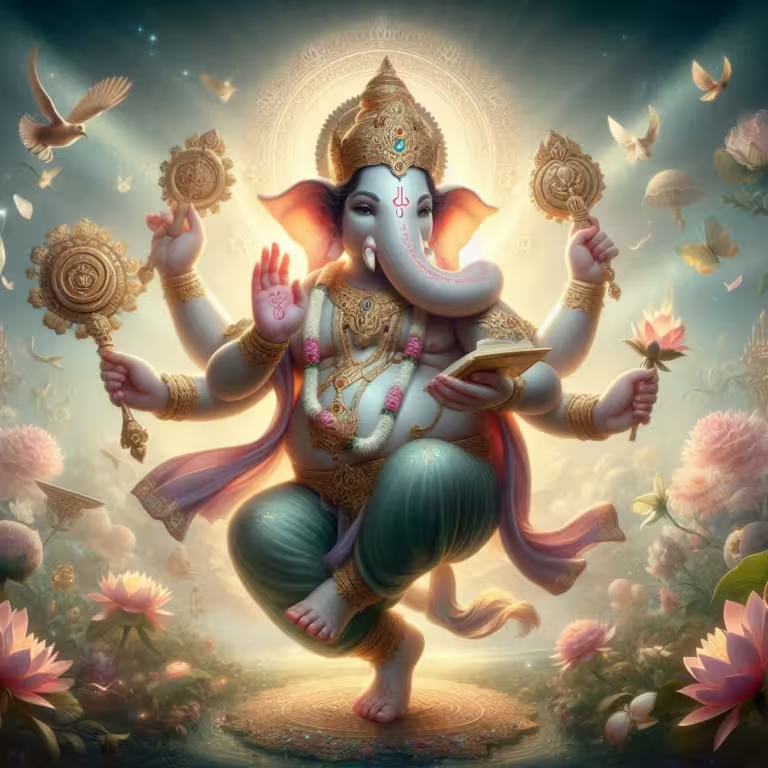Introduction to Kaal Bhairava
Kaal Bhairava is a powerful and fierce manifestation of Lord Shiva, revered as the ultimate guardian of the cosmos. He represents the destructive aspect of time (Kaal), clearing the path for creation and renewal. Beyond his terrifying form lies a deep spiritual significance that is explored across various traditions and practices. This blog delves into the multifaceted nature of Kaal Bhairava, his supreme role among the Ashta Bhairavas, his importance in Kashmiri Shaivism, and his presence in the Tantric practices of Vajrayana Buddhism.
Table of Contents
1. The Origin Story of Kaal Bhairava
The Conflict Between Brahma and Vishnu
The tale of Kaal Bhairava’s creation begins with a conflict between Lord Brahma and Lord Vishnu, who both sought to establish themselves as the supreme unchanging entity. Despite their divine status, they were misled by the illusionary power of Maya. The Vedas, when consulted, revealed that it was Rudra (Shiva) who was the true source of all creation, preservation, and destruction.
The Vedic Testimony of Rudra as Supreme
The Vedas affirmed the supremacy of Rudra:
- The Rigveda described Rudra as the entity in whom all beings reside and from whom everything emerges.
- The Yajurveda recognized Rudra as the seer and lord of all sacrifices.
- The Samaveda depicted him as the cosmic light that sustains the universe.
- The Atharvaveda proclaimed Rudra as the being beyond all misery, worshipped by the most devout.
The Creation of Bhairava by Lord Shiva
To correct Brahma’s arrogance, Lord Shiva created Kaal Bhairava, a fierce and terrifying form embodying the destructive power of time. Bhairava was commanded to punish Brahma, leading to the severing of his fifth head, which symbolized the annihilation of ego and ignorance. This act solidified Bhairava’s role as the enforcer of divine law and the protector of sacred spaces like Kashi (Varanasi).
2. The Ashta Bhairavas and Kaal Bhairava’s Supremacy
Introduction to the Ashta Bhairavas
The Ashta Bhairavas are eight fierce manifestations of Lord Bhairava, each governing different aspects of the cosmos and human experience. They are:
- Asitanga Bhairava – Associated with the direction East and connected with the element of water.
- Ruru Bhairava – Governs the South-East and is linked to fire.
- Chanda Bhairava – Rules the South and symbolizes the element of earth.
- Krodha Bhairava – Associated with the South-West and represents air.
- Unmatta Bhairava – Governs the West, linked to the element of space (ether).
- Kapala Bhairava – Rules the North-West and represents the mind.
- Bheeshana Bhairava – Governs the North and is associated with the intellect.
- Samhara Bhairava – Connected with the North-East and symbolizes the ego.
Kaal Bhairava as the Supreme of the Ashta Bhairavas
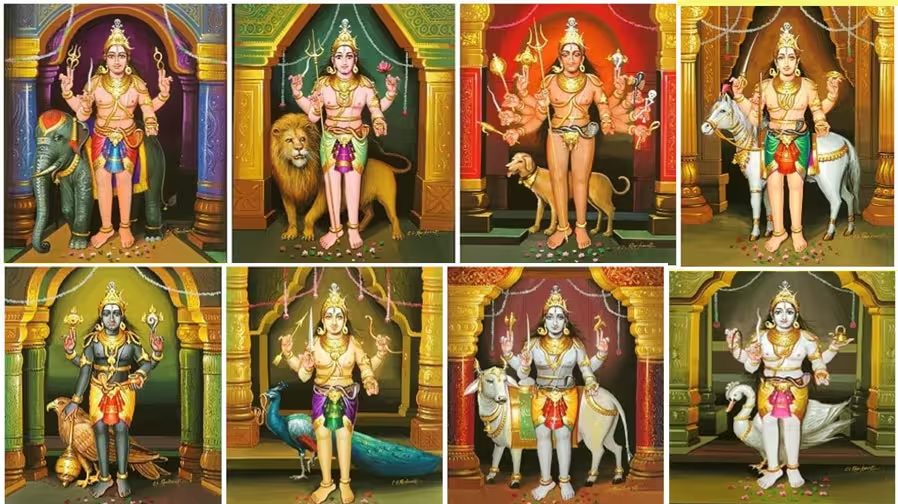
Kaal Bhairava is regarded as the supreme leader of the Ashta Bhairavas. While each Bhairava oversees specific cosmic functions, Kaal Bhairava transcends them all as the ultimate force of time and destruction. His role is to maintain cosmic order, punishing wrongdoers and protecting the righteous. Worshiping Kaal Bhairava ensures protection from negative forces and provides spiritual growth and liberation.
3. Kaal Bhairava in Kashmiri Shaivism
The Role of Bhairava in Kashmiri Shaivism
In Kashmiri Shaivism, Bhairava is more than a deity; he is the embodiment of the ultimate reality, representing the highest state of consciousness. Bhairava is seen as both the destroyer and the creator, and his worship leads to the dissolution of the ego, merging the individual soul with the universal consciousness. The concept of “Bhairava consciousness” is central to many practices, where the practitioner seeks to transcend duality and experience the non-dual state of Shiva.
Tantric Practitioners and Their Practices in Kashmiri Shaivism
Tantric practitioners in Kashmiri Shaivism focus on harnessing the energy of Bhairava through various rituals, meditations, and mantras. These practices are designed to awaken the latent divine energy (Kundalini) within the practitioner, guiding them toward self-realization and liberation. The practices are often intense and require strict discipline and guidance from an experienced Guru. The use of Bhairava mantras, yantras (sacred geometric patterns), and specific mudras (hand gestures) are common in these practices.
4. The Heruka Chakrasamvara Tantra and Kaal Bhairava
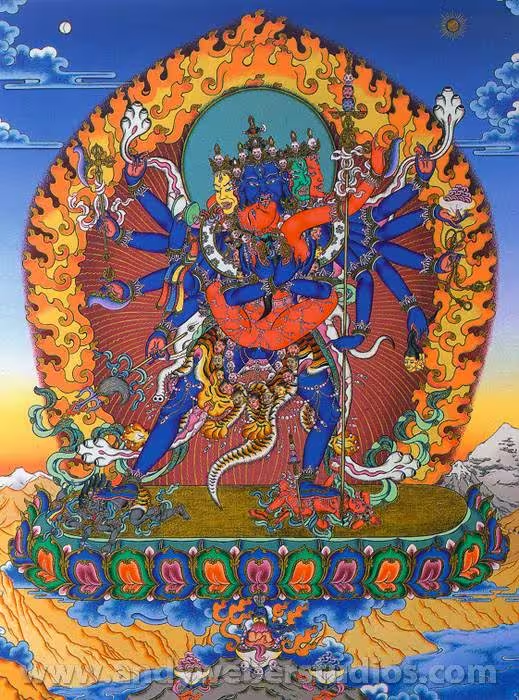
The Heruka Chakrasamvara Tantra is a central text in Vajrayana Buddhism that describes the practices and rituals associated with the deity Chakrasamvara, who is a manifestation of Kaal Bhairava. In this tradition, Kaal Bhairava is known as Heruka, a fierce protector who helps practitioners overcome obstacles and attain enlightenment. The tantra emphasizes the transformation of negative emotions into wisdom and the cultivation of compassionate action. The rituals associated with Heruka are complex and involve visualization, mantra recitation, and meditative practices aimed at achieving union with the divine.
5. Bhairava: The Central Deity of Aghora and Kapalika Sects
Bhairava holds a pivotal role as the central deity in the Aghora and Kapalika sects, two of the most intense and feared traditions within Tantra. These sects are known for their fierce and unorthodox practices, which often involve rituals and meditations that transcend the boundaries of conventional spirituality.
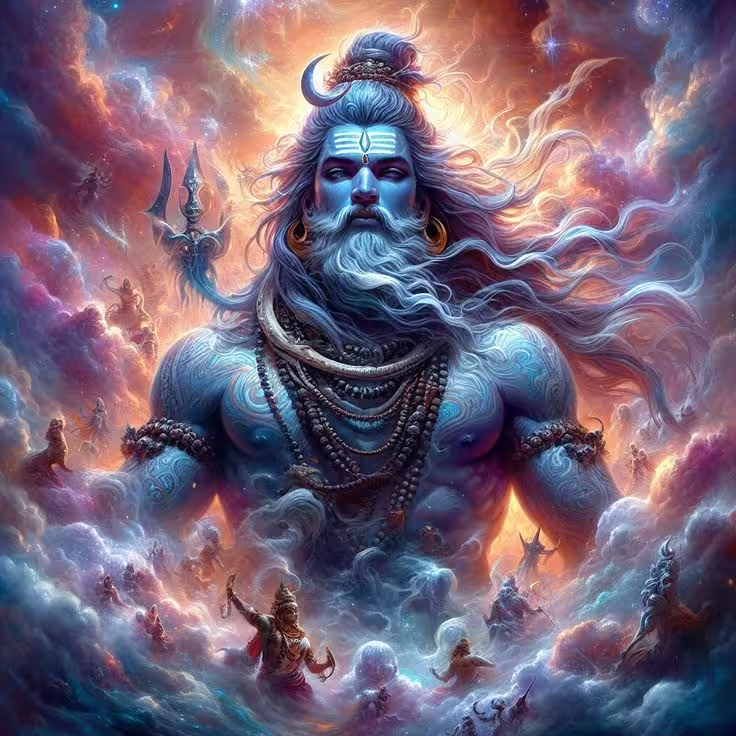
The Aghoris: Masters of the Fearsome Path
Aghoris are ascetic practitioners who embrace the path of Aghora, a spiritual tradition that seeks to dissolve the dualities of purity and impurity, life and death. For the Aghoris, Bhairava is the ultimate guide and protector, embodying the terrifying yet compassionate force that leads them to spiritual liberation. Aghoris engage in practices that are considered taboo by societal standards, such as meditating in cremation grounds, using human bones for ritual purposes, and consuming substances that others would find repulsive. These practices are designed to help them transcend fear, attachment, and the illusion of duality.
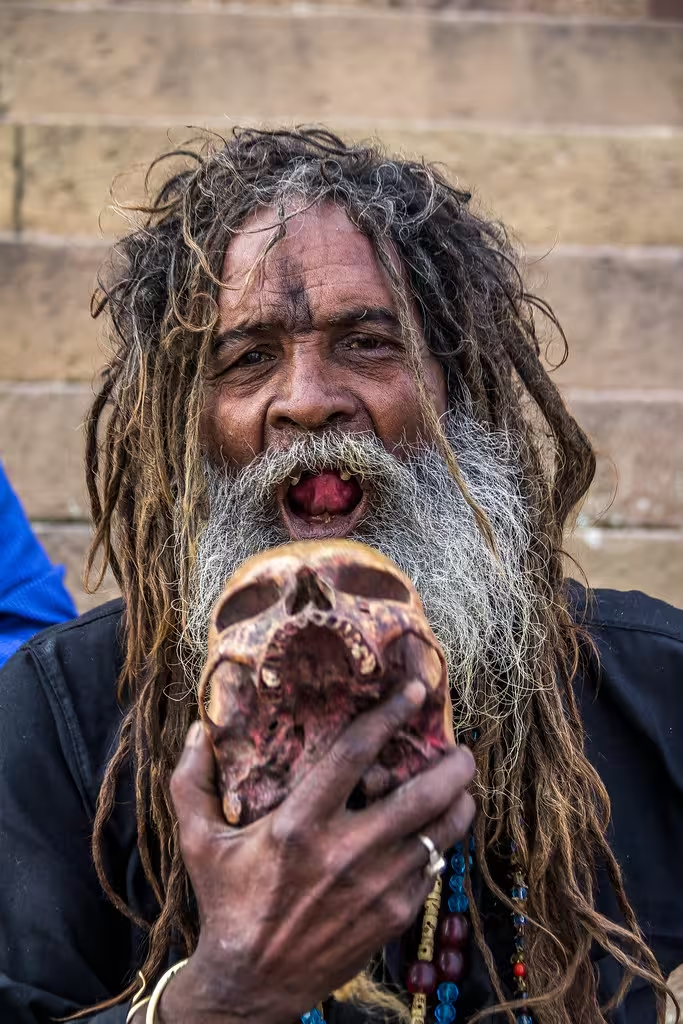
The potent energy that Aghoris harness through their connection with Bhairava enables them to conquer ghosts, spirits, and other supernatural entities. By invoking Bhairava’s power, Aghoris can exert control over these forces, using them as allies in their spiritual journey. Their mastery over such potent energies also allows them to manipulate the natural elements, achieving feats that seem miraculous to the uninitiated.
The Kapalikas: The Skull-Bearing Ascetics
The Kapalikas, or “skull-bearers,” are another sect that venerates Bhairava as their primary deity. Like the Aghoris, Kapalikas engage in extreme ascetic practices, often dwelling in cremation grounds and adorning themselves with skulls and bones. They believe that by embracing death and the macabre, they can attain the highest spiritual knowledge and power.
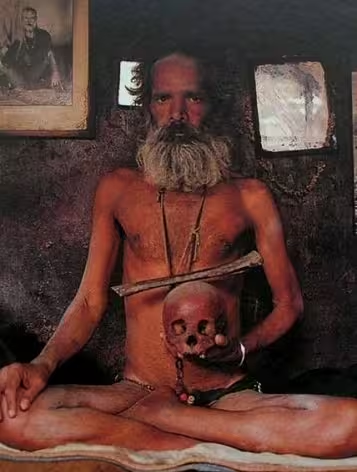
Bhairava, in his Kapalika aspect, is seen as the fierce enforcer of divine law, punishing the wicked and protecting the righteous. Kapalikas invoke his energy to gain control over ghosts, spirits, and other occult forces. Their rituals are intense and often involve the use of blood, flesh, and other substances that symbolize the impermanence of life and the cycle of birth and death.
The Potent Energy of Aghoris and Kapalikas
The energy that Aghoris and Kapalikas tap into is not for the faint-hearted. It requires immense spiritual strength, discipline, and fearlessness. These practitioners are known to wield extraordinary powers, such as the ability to control the weather, heal the sick, or curse those who have wronged them. Their connection with Bhairava allows them to manipulate the subtle energies of the universe, granting them access to the deeper mysteries of existence.
The path of Aghora and Kapalika is not just about mastering the forces of the external world; it is also about conquering the inner demons of fear, desire, and ignorance. By worshipping Bhairava and engaging in these fearsome practices, Aghoris and Kapalikas aim to achieve a state of non-dual awareness, where they realize their oneness with the divine.
6. Iconography and Symbolism of Kaal Bhairava
Kaal Bhairava is often depicted with a fearsome appearance, holding various weapons and symbols. He is portrayed with a dark complexion, wearing a garland of skulls and a serpent around his neck. His four or eight arms hold weapons such as a trident, a drum, a noose, and a skull cup, each representing his control over time, creation, destruction, and the cyclical nature of life. The black dog, his vahana (vehicle), symbolizes loyalty, protection, and the taming of unruly forces.
7. The Importance of Bhairava in Tantra Sadhana
Why Kaal Bhairava Must Be Worshipped First
In Tantra Sadhana, Kaal Bhairava is considered the gatekeeper to the esoteric practices. His worship is essential before engaging in any Tantric rituals, as he provides protection and removes obstacles from the practitioner’s path. Without his blessings, the intense energies invoked during Tantra practices can be overwhelming and potentially harmful.
The Necessity of a Guru in Bhairava Sadhana
The fierce nature of Bhairava Sadhana requires the guidance of a knowledgeable Guru. The Guru helps the disciple navigate the complex spiritual practices, ensuring that the energies invoked are directed positively. The Guru’s role is vital in safeguarding the disciple’s spiritual progress and preventing any adverse effects that may arise from improper practice.
8. Selected Shlokas Dedicated to Kaal Bhairava
- महाकाल भैरवाय नमः
Salutations to Mahakaal Bhairava, the great Lord of time, who devours sins and protects his devotees. - कालभैरवाय स्वाहा
Offerings to Kaal Bhairava, the lord who transcends time and space. - ॐ भैरवाय नमः
Om, salutations to Bhairava, the fierce protector and supreme guardian. - कालराजाय नमः
Salutations to Kaalaraja, the ruler of time and the enforcer of cosmic law.

If you are interested to learn more about beloved weapon of Lord Kaal Bhairava please do check the link: Bhairava Dand: The Ultimate Shield for Spiritual Protection and Success
9. Conclusion: The Eternal Guardian of Kashi
Kaal Bhairava stands as a powerful symbol of time, justice, and cosmic order. He is not just a fierce deity to be feared but a compassionate protector who guides his devotees toward liberation. His worship, especially within the context of Tantra and Kashmiri Shaivism, holds profound significance. Through the understanding and reverence of Kaal Bhairava, one can navigate the complexities of life with the wisdom and protection of the eternal guardian of Kashi.
It is very crucial for one to have a competent guru to dive deeper in Kaal Bhairava tantric lineage. If you are interested then please do check this link.

